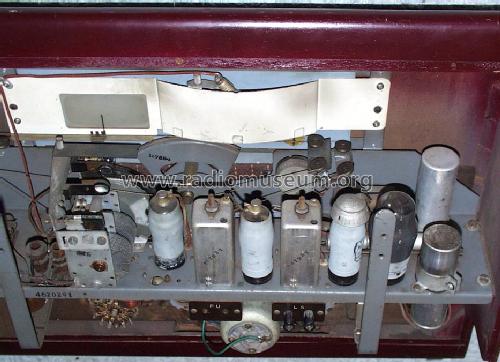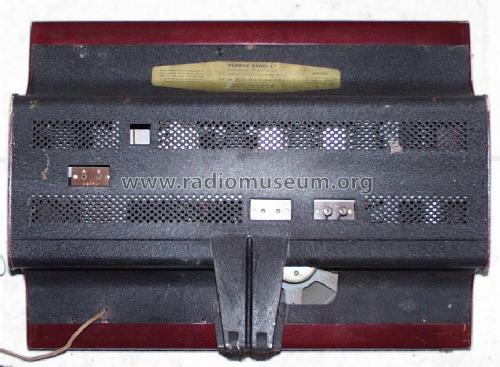- Country
- Great Britain (UK)
- Manufacturer / Brand
- Murphy Radio Ltd.; Welwyn Garden City
- Year
- 1946
- Category
- Broadcast Receiver - or past WW2 Tuner
- Radiomuseum.org ID
- 78985
Click on the schematic thumbnail to request the schematic as a free document.
- Number of Tubes
- 5
- Main principle
- Superheterodyne (common); ZF/IF 465 kHz; 1 AF stage(s)
- Tuned circuits
- 6 AM circuit(s)
- Wave bands
- Broadcast, Long Wave and Short Wave.
- Power type and voltage
- Alternating Current supply (AC) / 110/240 Volt
- Loudspeaker
- Permanent Magnet Dynamic (PDyn) Loudspeaker (moving coil) / Ø 16.5 cm = 6.5 inch
- Power out
- 4 W (unknown quality)
- Material
- Wooden case
- from Radiomuseum.org
- Model: A104 - Murphy Radio Ltd.; Welwyn
- Shape
- Design Radio or Novelty / Gadget - fancy or unusual shape.
- Dimensions (WHD)
- 23.75 x 18 x 5.5 inch / 603 x 457 x 140 mm
- Notes
- Separate SW dial using optical projection with magnifying lens.
First shown at the "Britain Can Make It" Exhibition. First of the baffle board series. Can alternatively be hung on the wall.
- Net weight (2.2 lb = 1 kg)
- 12.6 kg / 27 lb 12.1 oz (27.753 lb)
- Source of data
- Radio! Radio!
- Author
- Model page created by Konrad Birkner † 12.08.2014. See "Data change" for further contributors.
- Other Models
-
Here you find 367 models, 301 with images and 235 with schematics for wireless sets etc. In French: TSF for Télégraphie sans fil.
All listed radios etc. from Murphy Radio Ltd.; Welwyn Garden City
Collections
The model is part of the collections of the following members.
Forum contributions about this model: Murphy Radio Ltd.;: A104
Threads: 1 | Posts: 1
Mein Gehäuse ist in einem deckenden Weinrot lackiert, so dass die Holzmaserung nicht sichtbar ist. Es ist sehr sauber gearbeitet, so dass ich nicht beurteilen kann, ob es original oder restauriert ist. Auf der Rückseite sieht man die Übergänge der aufgespritzten Farbe zum Holz.
Von den beiden Elkos ist einer ausgetauscht worden. Sie sitzen jedoch beide verschieden hoch in den Halteschellen. Wie war die ursprüngliche Anordnung?
Von den beiden Elkos ist einer ausgetauscht worden. Sie sitzen jedoch beide verschieden hoch in den Halteschellen. Wie war die ursprüngliche Anordnung?
Harald Pohlmann, 15.Mar.06













